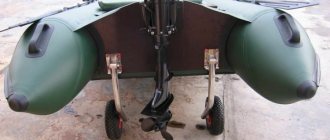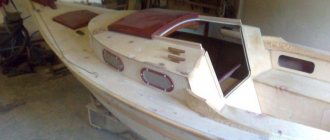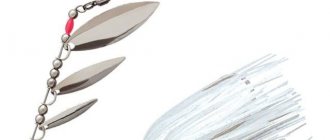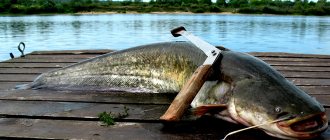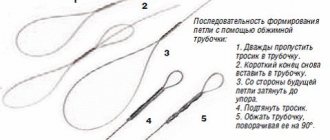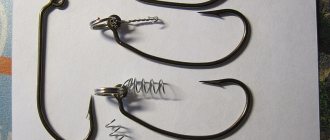Many fishermen who use PVC inflatable boats for fishing purchase or make their own transom wheels, which make it easier to transport the boat from the place of assembly and completion to the reservoir.
Transom wheels consist of the main elements:
- wheels with hubs;
- fastening mechanism with a set of bolts and nuts.
Mounted directly on the boat transom using fasteners and bolts.
Various types can be used, each with certain characteristics:
- plastic;
- cast;
- inflatable.
The best material for racks is stainless steel, which provides structural strength and reliable protection against corrosion.
Plastic ones are made of plastic that has sufficient strength. To increase strength, discs can be made of metal. Particular attention should be paid to the material of the racks, which bears the main load during transportation.
Cast wheels are made from a special alloy that has sufficient strength and low weight. Various models are available with excellent design and appearance.
Inflatables have a metal disc and a rubber tire. They have good cross-country ability, but tire damage may occur when transporting an inflatable boat over rough terrain.
Wheels can be equipped with special bushings or bearings. Most anglers prefer wheels equipped with fluoroplastic or caprolactam bushings, which ensure reliable operation in various weather conditions and exposure to dirt and dust.
Wheels equipped with bearings require careful maintenance and constant lubrication. A prerequisite for long-term operation is the presence of bearings equipped with special protection from dirt and moisture.
Manufacturing
Having decided to make transom wheels with your own hands, it would be useful to draw up a short action plan in advance.
You will also need to prepare all drawings of the vehicle, which will indicate the dimensions of the elements used. A properly assembled and fastened boat can support a weight of up to 150 kilograms. The following tutorials are focused on creating a vehicle that will be used to move one person over distances of up to a kilometer. For installation, 4 bolts are used that are attached to the plywood transom. In the future, it is possible to change the height of the installed fastening using a special pin, for which it will be enough to unscrew the nut on the side of the structure.
You can make wheels without drilling the transom according to the following plan.
- Choosing the optimal location for installing a square profile. It is necessary to ensure that the installed structure does not interfere with engine operation.
- You need to measure the radius of the wheels and add 5 centimeters. This is the distance from the edge of the transom where the wheels will be mounted. It is believed that the indicator obtained in this way is optimal for self-propelled structures.
- It would be preferable to install the bracket at a right angle. This will ensure the strength of the device, which will be able to withstand significant loads.
It is worth keeping in mind that the main difference between the two methods provided is that when following the instructions of the second method, the wheels are located under the bottom of the boat. This is a little more difficult to do, however, when using a circuit of this kind, nothing will interfere with the operation of the boat engine.
Plan for making wheels using drill and welding equipment.
- It is required to cut 4 pieces of the length required for the structure from a profile prepared in advance. Next, you need to attach the resulting elements to the lower area of the profile.
- To secure the rings in the tubes, you need to drill several through holes. A nut prepared in advance to size is also welded inside the tube. This is necessary so that some distance remains between the fasteners and the structure.
- To isolate the inside of the system from possible moisture ingress, rubber or plastic quick-release plugs are attached from the outside.
- There are a few holes to be drilled on the front bow that will be needed to mount the landing gear to the transom.
- Next, both fastening elements need to be welded together at an angle of about 45 degrees. If necessary, the edges need to be adjusted.
- After carrying out all the above steps, the chassis must be secured with tubes using nuts and washers.
Upon completion of all the above steps, the boat with transom quick-release wheels will be ready for use. If desired, you can carry out additional cosmetic actions, for example, paint the device or purchase special stickers for it.
Advantages
Do-it-yourself transport wheels for PVC boats have a fairly large number of advantages:
Save time. Of course, everyone understands that wheels will help significantly speed up the process of unloading the boat. If this is an inflatable boat, then you won’t have to carry a heavy load from the car to the pond, but you can simply take it out, inflate it and bring it. It's much more comfortable.Read here - DIY boat anchor: making a homemade anchor for PVC boats (95 photos and videos)
Unlimited service life. These devices can last for a very long time, you just need to take care of them. Try not to run into screws or other sharp objects, otherwise the tires will require replacement. Typically, such structures last quite a long time.
Comfort. Naturally, this advantage is one of the most important. Many people simply love it when everything goes smoothly and without difficulties. These wheels allow you to do everything perfectly.
Mobility. Such wheels, as a rule, take up extremely little space, which allows them to be considered mobile. They can be stacked on top of each other, then you won’t even notice that they are in the trunk.
Check it out here too!
How to make a fishing screen: description and step-by-step instructionsFishing knots diagrams: the best fishing knots for all occasions
How to make a fishing hook at home: master class with photos
Comfortable handling of the boat. The transport wheels have very good controllability, which makes it easy to turn and radically change the direction of the boat.
Ease of construction. If you look at the drawings of boat wheels, which, fortunately, are abundant on the Internet, you can be convinced that the design is quite simple to manufacture and does not require any special skills.
Let's work with our hands a little
We remember that in no case should they interfere with the motor, even if the fasteners become loose and the fasteners dangle freely. Otherwise, you can say goodbye to the screw.
When the attachment points are determined, we set the segment down - the wheels themselves should be slightly below the lower edge of the transom - by the length of the radius plus 3-5 centimeters. This will provide the required level of safety and at the same time reduce resistance to water when moving. The brackets for mounting the wheels can be left straight, or they can be made at a slight angle.
The brackets, welded at an angle, allow the wheels to be located under the bottom of the boat and not interfere with the operation of the motor. Let's consider the second option, as it is more complex.
Let's cut off four sections from the profile - in this drawing they have certain dimensions, but you take those that are suitable specifically for your boat.
In addition, immediately weld a nut of the appropriate diameter to the inner ring of the tube so that the wheels are not pressed against the mount.
In the upper part, use a drill to make two small through holes - it is through them that you can later install the wheels on the transom.
Of course, the ends will have to be trimmed slightly so that they fit tightly together at this angle.
When the welding work is completed, all that remains is to put the wheels on the tubes and secure them with a washer and a cotter pin. That's all. Homemade transom wheels are ready. If desired, the mount can be painted with waterproof paint - just for beauty. It's time to move on to the next stage - installation on the transom.
DIY making
To save money, you can make the transom mechanism yourself. To do this, you must first prepare a drawing of the device with a choice of product design, taking into account the size of the boat and the permissible load on the wheels.
Next, a selection of the necessary materials for the manufacture of fasteners for the device is made.
Materials
The following materials are used for this:
- Metal profile made of stainless steel with a section of 25x25 mm or 30x30 mm.
- Wheels with a diameter of 26-35 cm, having a durable design and capable of supporting the permissible weight when transporting the boat.
- Tubes for mounting wheels on the transom.
- Fastening parts: bolts, nuts, washers, cotter pins.
To perform the entire range of work, you need a set of metalworking tools, a welding machine with electrodes and cleats for fixing workpieces during processing.
Step by step process
We perform a number of actions:
- On the transom, we mark the attachment points of the mechanism, taking into account its position (working and folded), and the installed outboard motor, ensuring free access.
- We drill the transom for bolts to mount the device in compliance with safety conditions during operation.
- We attach the brackets to the transom, taking into account the design used and the type of device, which can be installed at a right angle or at a given angle.
The brackets can be installed at the required angle when the wheels are mounted under the bottom of the boat. To do this, a frame is made from 4 profile sections, and tubes for mounting the rings are welded in the lower part.
Holes are drilled in the tube to fasten the rings using cotter pins.
It is also necessary to take into account that it is necessary to weld the nut to the inner ring of the tube to prevent friction with the fasteners.
The ends of the tubes also need to be insulated using plugs to prevent water from getting inside. The mechanism structure is connected by welding and assembled for operation using washers.
It is also necessary to take into account that it is necessary to weld the nut to the inner ring of the tube to prevent friction with the fasteners.
Features of installing transom wheels on a PVC Solar boat
The boats have a low pressure inflatable bottom. The transom sits on top of an inflatable bottom that protrudes beyond the transom. At the bottom of the boat along the entire length between the cylinders there is a special apron made of PVC fabric, which allows you to go on planing. This explains the use of transom wheels with an extended post and a curved design (or installing the post in the working position at an angle to the transom) to avoid bending the apron.
When marking the installation of the bracket on the transom, it is necessary to take into account the thickness of the inflatable bottom. You can use wheels with an extended stand of a straight design, but in this case you will have to insert spacers (plywood, textolite) between the bracket and the transom, and also use bolts of increased length.
Installing transom wheels on a boat: instructions
Immediately before use, the completeness of the structure and the presence of all fasteners are checked once again. The build process itself looks like this:
- The boat is assembled according to the instructions.
- A rigid bottom is placed in the body, and the cylinders are inflated.
- The racks are placed on the mounting bolts protruding over the side.
- The stands are secured with nuts.
- The motor is installed.
The watercraft is ready for transportation.
Primary requirements
It is not difficult to purchase ready-made transom wheels for transportation - they can often be found in a regular fishing store. The main inconvenience in this case is the unreasonably high cost. Transom wheels for boats made of PVC with NDND, which will be used only for transporting the unit to the reservoir and back, will cost the fisherman a tidy sum of 5,000 rubles.
Due to the high cost of these parts, indispensable for quick transportation, many fishermen are interested in how to make homemade wheels for a rubber boat with their own hands.
You need to understand that when making wheels yourself, in order to avoid collapse of the structure, certain requirements must be observed.
- The axle of the transom wheels should be installed as close as possible to the center of gravity.
- To reduce the effort that will be applied during transportation, it is worth installing the bend of the rack towards the bow of the boat, and not vice versa.
- It is imperative to leave a gap between the bottom of the boat and the edge of the wheels, which should not be less than two centimeters. This avoids clogging of parts with dirt and makes the cleaning process easier.
- When choosing materials, it is worth considering the conditions of further use. This involves taking into account the humidity level in the area, regular exposure to moisture, as well as serious temperature changes. As a rule, preference is given to stainless steel, aluminum, galvanized iron or conventional rolled steel.
- The greater the distance between the wheels, the more stable the overall structure of the boat will be.
- Transom wheels should be installed in a strictly vertical position.
- The wheel stand should not be facing towards the motor - it should be placed with the front side facing the cylinder.
Do not forget that all materials and fasteners must be made of stainless steel. Of course, it is also possible to use elements made of ordinary metal, however, in this case you will have to spend money on waterproof varnish or paint.
Tips for use
The use of transom wheels in a rubber boat has some features in its operation:
- Despite the reliability of the racks and the presence of rolling bearings in the disks, this design is not intended for transporting a boat as a trailer to a passenger car.
- During long-term storage in the autumn-winter period in a folded state, it is recommended to remove the racks and lubricate the threads with a neutral lubricant that does not destroy the rubber base of the cylinders.
- After each use, both the boat and the wheels must be cleaned of dirt and washed with water, after drying, check the presence of all fastening elements and drain any remaining moisture from the voids of the racks.
- When transporting a boat, it is not recommended to load the boat with additional cargo , although the design of the wheels is quite strong, it is quite difficult to control a loaded boat with a motor.
Advantages of homemade wheels
Today on sale are various quick-release, folding wheels for PVC boats, as well as other types of designs. They are made of materials that are not subject to corrosion. If the wheels are made of metal, the surface must be treated with special compounds. The presence of defects on the material indicates low quality of the product.
Read Techniques and tactics of fishing with an elastic band and its installation with your own hands
The cost of purchased structures for transporting a boat can reach 10 thousand rubles. Not every fisherman can allocate a similar amount of money from the family budget to purchase wheels. Homemade structures cost about 2 thousand rubles.
These wheels are ideal for a PVC boat. When creating them, you can take into account the configuration and features of the vessel. In this case, you can create a stable, durable structure. It will serve its owner for many years. Wheels can be purchased at specialized stores. But you can make the frame and supports yourself.
Installation Features
The procedure for attaching transom wheels to a boat is quite important, since in case of negligence the hull of the craft can be damaged. For this purpose, the user must refer to the wheel operating instructions, which describe this procedure in detail. Nuances may arise depending on the characteristics of the chassis.
General recommendations for installing wheels on a boat.
- The wheels are attached to the watercraft in an uninflated state.
- When attaching chassis elements, you should make sure that the gusset, floorplates and other parts are not damaged during installation.
- Connections are marked. For this purpose, you need to attach the fasteners to the transom, and then use a pencil to mark the boundaries. It is worth remembering that in this case you need to leave a gap of 10 centimeters below the transom.
- Holes are drilled. This procedure should be carried out according to the points that were previously outlined. To make the process more precise, you can use a square.
- Holes and parts are treated with sealant. This measure provides additional protection against rotting and moisture. Sealants also promote bond strength.
- Installation of fasteners. The mounting plate must be tightened with bolts in which washers are pre-installed. Tightening the nuts should not be done quickly; you should observe smoothness and sequence.
- Installation of wheels. You need to mount the frame under the wheel on the mount. The next step is to insert the chassis retaining bolt. Lastly, install the wheel and secure it with a nut.
Attaching the landing gear to the watercraft usually takes from 60 to 120 minutes. The speed of this procedure is influenced by the skills of the master and his experience in this matter. To make transporting the boat as simple as possible, it is better to use transom wheels. If you want to save on the purchase of this device, the boat owner can make the wheels himself.
When choosing accessories for moving a watercraft, you should give preference to those whose fasteners are made of stainless steel.
To learn how to make transom wheels for a PVC boat from scratch, see the following video.
Purpose of wheels
Before you start making transom wheels with your own hands (drawings and instructions are available on many fishing forums), you need to understand the basic characteristics and purpose of the accessory. Making such a structure from available materials is not difficult at all, even for a novice fisherman.
Having transom wheels on a boat is a must for productive solo fishing. In essence, they are a small chassis fixed to the craft using two brackets. It is these brackets that put the wheels into working condition, moving up and down.
With the help of good transportation elements, you can easily transport the boat along the shore, lower it into the water, and also lift it from the reservoir to land. Once the boat has splashed down, there is no need to remove the wheels: they simply rise up. When installing transom wheels on a PVC boat, you need to carefully look at the way the brackets are placed. It is on this that the driving performance on the shore and the turning characteristics of the engine when moving through water depend.
Store models come in different widths and sizes. In most cases, anglers purchase medium-sized wheels that allow them to comfortably move the boat along a sandy beach or hard ground. The connecting elements are made of durable, moisture-resistant materials.
If you don’t want to make wheels by hand, you can find a good option at a specialized retail outlet. Firstly, this approach will save valuable time, and secondly, a wide variety of models with any characteristics are available for sale.
Main types of transom wheels
Depending on the fastening features, wheels for an inflatable boat are divided into four types:
- Reversible. Available for use in two positions: lowered – for transporting the boat along the shore; raised - for unhindered movement of the craft through the water.
- On clamps. The installation process does not require the use of special tools - the racks are attached to the transom with clamps.
- In stiletto heels. In essence, it is a type of quick-release wheels. For installation and dismantling, it is necessary to perform manipulations to fix the cotter pin.
- Quick release. Installation requires only one position. Once the boat is in the water, these wheels can be easily removed in one motion.
Quick-release wheels have a neat and reliable fastening
When choosing the optimal type for a boat, you need to pay attention to the shape of the rack. It is worth understanding that the design intended for soldered watercraft is definitely not suitable for inflatable boats NDND, since the bottom protruding beyond the plane of the transom will not allow the installation of straight racks
Example of reversible transom wheels in two positions
Transom wheel design
Structurally, transom wheels consist of:
- unit for attaching the posts to the transom board;
- racks;
- wheels
Each of these elements is important in its own way and requires the fulfillment of a number of specific conditions for the practical implementation of the project during self-assembly.
Rack mounting unit:
- Must ensure rigidity of fastening of the structure to the hull through the transom board.
- The design of the fastening unit must be universal: in the lower position, the wheels must be below the level of the motor propeller, and when raised to the upper position, they must not interfere with the control of the craft.
- All parts of the assembly must have a safe surface; they should not have sharp corners, burrs, frozen drops of metal from electric welding; when storing the boat, they should not cause rupture of the cylinder body.
Racks:
- Racks of various designs and versions must be able to withstand the weight of the boat and outboard motor.
- The racks must provide reliable fastening of the wheel axles.
- The dimensions of the racks should correspond to the size of the outboard motor and the boat - the racks should ensure safe movement of the boat with the engine attached and at the same time should not be too long, since a too high center of gravity will make movement difficult.
Wheels:
- The width of the tires should ensure unhindered movement both on ordinary hard surfaces and on swampy terrain and sand.
- The diameter should be at least 300-350 mm; this size will allow you to move freely both on a flat surface and on a surface with complex terrain.
- Since the wheels and tires will be partially submerged in water, it is necessary to consider using sealed bearings or bushings.
In addition, you should pay attention to the peculiarities of the connection between the design of the transport wheels and the boat hull. Here the most vulnerable point is the bolted connection and holes in the transom. Such a connection must not only be made correctly in structural terms, it should not interfere with any of the structural elements of the boat - the bottom, cylinders, the engine mounting location, but also ensure the tightness of the connection.
The tightness of the connection here means not only ensuring tightness from water entering through the holes into the vessel, but also preventing moisture from penetrating into the middle of the board, because the board itself is usually made of multi-layer plywood.
Transom wheels for PVC boats and their features
First of all, it is worth noting that the transportation device can be on wheels of either large or small diameter. Size in no way affects the stability of the entire device.
The device itself is a rigid metal frame with wheels. The features of the product are the following criteria:
- the frame must be made of stainless steel, since the boat itself and its transportation are inextricably linked with the aquatic environment;
- the frame frame is a welded structure made of 30x30 mm pipes and U-shaped brackets;
- When choosing a route, you should take into account the road, depending on which the transom wheels will differ (it is better to use narrow ones on asphalt, and wide and low ones on sandy soil).
- the load on the wheels is calculated based on the weight of the boat, which means that the diameter and material will depend on the weight of the vehicle being transported.
- the chassis should be easy to move into working position and fold;
- Inflatable bladders are used throughout the entire wheel system so that the tire can be inflated or deflated at any time;
- the design must be convenient for one person to operate;
The use of a transport structure for PVC boats makes the boat easier to use and allows you to use it more often.
Tips for choosing and popular models of transom wheels for PVC boats
So, we’ve talked about the types of chassis, now it’s time to talk about choosing the right wheels for your boat. If you want to buy boat chassis or make transom wheels for a boat with your own hands, you need to be at least a little familiar with the parameters of this device. Among the main characteristics are:
- Load capacity. Here you need to calculate the maximum weight of the boat with motor and gear. For some, 100 kg is enough, while others will need all 200 kg.
- Diameter and width. It is believed that the larger the wheel, the better its travel and uniformity of load distribution.
- Bearings. For boat wheels, plain and ball bearings are used. The former have high friction and the danger of jamming, while the latter do not have these disadvantages. But in terms of price, ball bearings are much more expensive.
- Type of construction and materials. These factors are discussed in detail above.
Also, in the question of how to choose the right transom wheels for PVC boats, a review of popular models of boat chassis will help. Let's give a few examples.
| Model name | Characteristics | Price (in rubles) |
| Laker Transom Wheels | Low price, quick installation, improved design, designed for transportation over rough terrain. | 3 000 |
| Sun Marine 260 mm | Removable stainless steel chassis, proven to be sufficiently powerful and highly reliable. | 4 200 |
| Horizon KN-260 | Removable wheels on the boat with the possibility of fixing at the top and bottom. They are distinguished by great strength and high load capacity (up to 450 kg). | 4 200 |
| TKM 260 mm | Stainless steel, quick-release, with up-down fixation, without bearings. | 4 400 |
You can ask the store for the models presented, or select the appropriate chassis among analogues.
Why is this necessary?
Launching a boat and pushing it back to shore can be quite difficult. This sometimes causes difficulties for strong, physically developed people. Often there are watercraft that, with a length of 3.6 m and the installation of a motor, “pull” 100 kg. And this does not even take into account fuel, transported cargo, catch or hunting spoils. You can, of course, involve an assistant in the task, but this does not always work out, and why would you, when there is an excellent solution - installing special wheels.
But you can still somehow come to terms with the heaviness. But it is undesirable to put up with excess friction. When a boat is dragged against rocks when landing on an unequipped shore, it will inevitably become covered with scratches. And maybe it will even be cut a little. Yes, modern materials allow the structure to withstand such events without any special consequences.
Functions
The functional tasks of transom wheels include:
- Simplify the process of delivering a boat from shore to water.
- Make the craft mobile.
Considering the significant weight of a boat equipped with an outboard motor, lifting and moving it to the right place is already difficult for one person.
Of course, you can call for help, but why, when transom wheels are provided for such purposes.
They are the ones who make it possible for the owner to save strength, to freely deliver the vessel to the reservoir and to provide a good mood for fishing.
The name of the accessory determines their mounting location; they are installed on the rigid transom of an inflatable boat. Thanks to such a simple device, one person can easily do without outside help to launch an equipped vessel into the water and then lift it ashore.
The main thing is to correctly fix the fastenings to the transom once, so that you can use them without problems in the future.
Why use it
Fishermen who use inflatable boats without boat wheels know how difficult it is (even with two people) to move the equipped vessel from the car to the water. The reason for this is the total weight:
- inflated PVC boat - about 50 kg;
- motor - about 35 kg;
- anchor - at least 10 kg;
- oars, transom and additional equipment - approximately 40 kg.
Read Feeder equipment - a guide for beginners
You can also add here the weight of the canister with stored fuel, which is about 25 kilograms. In total, the boat ready for launching weighs at least 160 kg.
The wider the wheels, the more maneuverability they can provide. Important! Transporting a watercraft by dragging is dangerous, as there is a risk of damaging the bottom from stones, glass and other objects that may be on the shore. Obviously, the presence of wheels can solve the issue of launching.
For which PVC boats
The external transom for an outboard motor must correspond in size and other characteristics to the parameters of a particular PVC boat. Both the size and design features of the craft matter.
Important! Before making a homemade transom, it is imperative to familiarize yourself with the technical characteristics of your PVC boat and the motor that you plan to install on it.
If the purchased boat is not equipped with a motor, then it is designed for rowing on water. But, even for such models, the installation of motors is allowed, but not more powerful than 3 hp. This will allow you to reach speeds of up to 10 km/h, which is enough to overcome the water both downstream and in still water. It is the motors that are small in power and weight that can not overload the craft and not put the thin PVC material at risk.
Even small-sized boats can be equipped with homemade dances
Kinds
Transport chassis are available in the following varieties:
Transformers KT-5
This model has a bolt design, where the chassis is mounted parallel to the boat transom in the folded position, which allows you to pack the inflatable craft without removing the chassis.
This design is very beneficial for the user: it is convenient, compact, and in the stowed position, the chassis is placed behind the transom and does not interfere with the control of the vessel.
Due to its functionality, the KT-5 design ensures comfortable movement of the boat by one person, where there is no need to seek outside help.
The material used for the base mounted on the transom of the vessel is steel with a thickness of 3 mm. For the wheel stand, a profile pipe with a system of grooves is used, which facilitates quick installation, removal or changing the position of the chassis from working to traveling.
The wheels of this type are equipped with an automatic spring mechanism, which allows you to move the boat over uneven surfaces (they do not form backlashes or rattles).
Automatic (KT-3N, KT-3NU)
This model is made of stainless steel, equipped with an automatic locking system, and is used for inflatable boats with a stationary transom, or for small boats with a rigid hull.
Advantages:
- High quality material and workmanship.
- Reliability.
- Great design.
- The optimal solution for moving a vessel over long distances.
- Ease of use (easily and simply brought into operating position and also assembled).
In the production process of automatic wheels of the KT series, laser cutting is used, and the seams are welded by argon welding, resulting in high precision and original appearance.
This design is capable of supporting a loaded boat weighing 120 kg.
Folding
The product is installed on the outer side of the transom, which allows you to easily fold the chassis down and down. To fix the product, springs are used, located inside a stand made of stainless steel.
Not only the racks, but also other parts are made of stainless steel and are extremely durable, resistant to fresh (product KS-03) and sea (product KS-04) water.
Advantages:
Easy to remove and fold
There is no need to mount and dismantle the product every time
Manual fastening method, do not interfere with vessel control
There is an option for packing a deflated boat with wheels; it is used for all types of PVC inflatable boats; the maximum load on the wheels is 180 kg.
Tilt&Turn
The model is used to move an inflatable boat by one person over short distances.
Mounted to a plywood stationary transom using 4 bolts. Thanks to the rotating device, the position is adjusted up and down due to the mounting pin.
To dismantle the accessory, simply remove the nut located on the side of the stand. Any car pump is suitable for inflating the chambers. The maximum load capacity of the chassis is 140 kg.
All parts are made of durable stainless steel, and the discs are made of premium plastic.
Manufacturing process
Making transom chassis at home is not difficult. Every self-respecting man probably has everything he might need in his garage.
There are a lot of well-known, simple ways to place transom wheels on a boat, both with fasteners and those that do not require traditional fastening.
One of the easiest ways and quite quick in time is to install transom structures on a small boat, on the rear on balloon handles.
To do this, you will need a plastic barrel, from which two main elements 20 cm wide will be cut.
Special ties are cut along the edges of the barrel, which will act as the basis for fasteners. And the chassis itself will be installed in the middle of each part on four stainless steel bolts. All holes must be filled with silicone as a sealant.
Of course, every fisherman has his own methods for improving the boat; for this, you may need various additional parts installed yourself, which will significantly save effort, time and money.
There is also an excellent option for installing transom chassis on special stainless steel brackets. It is the most practical and simple of all known and inexpensive.
So, to make transom wheels with your own hands you will need:
- square pipe 25*25*2 – 1.2 m;
- round pipe 20 mm, external Ǿ 17 mm and internal Ǿ – 0.5 m;
- round pipe 23 mm (outer dia.) 20.5 mm (inner dia.) – 0.05 m;
- rod Ǿ 16 – 18 cm;
- Washers Ǿ 20 – 4 pcs.;
- Washers for M10 bolt – 8 pcs.;
- Bolt with nut M10 – 4 pcs.;
- Cotter pins Ǿ 4 – 2 pcs.;
- Electrode 3.2 – 2 pcs. for the manufacture of knitting needles;
- Furniture plug 25*25 – 2 pcs.;
- Wheels 26*85 with needle bearings – 2 pcs.;
- Special primer for metal structures;
- Special enamel;
- Transparent silicone;
- Drill Ǿ 20;
- Drill Ǿ 4;
- Grinding wheel;
- cutting circle;
- brush.
So, having prepared everything you need in advance, you can safely move on to making transom wheels. Initially, you need to prepare the wheel itself, for example, from ordinary wheels from a children's bicycle or purchase ready-made ones.
From the prepared pipes, make the base of the bracket according to the drawing.
Some joints will need to be welded, since there will be a large load on the frame and the threaded connection may not withstand it. For welding work, it is better to invite a specialist who has specialized equipment in his arsenal.
It is best to order special rotating pins on which the wheels will be mounted from a turner, who will perform the work in accordance with GOST with tolerances and appropriate fits for the hole.
Read How to prepare semolina for fishing
In the finished structure, drill holes for future fasteners and clean them with a file.
After the frame is ready, at the last moment it is necessary to install the fingers and put the wheels on them. This way the transom wheels will be ready for installation. This kind of work takes little time, but the savings are enormous!
Content:
- 1 Functions of transom wheels
- 2 Advantages and disadvantages of having transom wheels
- 3 Types of transom wheels 3.1 Transformer KT-5
- 3.2 Automatic KT-3N and KT-3NU
- 3.3 Folding transom wheels
- 3.4 Tilting chassis, for PVC boats
- 4.1 Drawing
But, in order not to pay extra money, you can make such wheels yourself, at home, especially since there are no particular difficulties. They are especially necessary in conditions where fishing is carried out alone, although, as a rule, fishermen go fishing in groups of several people.
Transom wheels for a PVC boat are a transport chassis that is secured using 2 brackets. With the help of these brackets, the wheels are moved to the transport position or vice versa.
The presence of transom wheels makes the boat more functional. Without outside help, it can be moved along the shore, pulled out of the water and launched into the water. Their advantage is that there is no need to remove them when launching: it is enough to move them to the appropriate position.
In the process of equipping a boat with such a device, special attention should be paid to the placement of fasteners on the transom. Their position can affect the maneuverability of the boat, both on water and on land.
Independent production of transport products
Transom chassis are not a complex technology that is only available to factories with specialized technical equipment. The ease of the mechanism lies in the fact that it can be installed at home.
The chassis design comes in several forms:
- folding chassis;
- transformable wheels;
- rotating chassis;
- folding design;
- removable transport product;
- automated system.
First of all, we decide on the materials and type of wheels. Metals used in the product:
- stainless steel;
- aluminum or duralumin;
- galvanized metal.
Platforms for attaching the chassis to the transom and beams with fasteners for disks are made from metals.
The following wheels are used:
- cast;
- inflatable;
- plastic.
Cast ones are characterized by low cost, durability, low operating and maintenance costs. However, in loose soil and sand they are ineffective.
Inflatable - pumped up with air. This type has increased cross-country ability. However, there is a high probability of getting a puncture or cut in the tire.
Plastic chassis are used when moving on hard surfaces. They are stable, durable and aesthetically attractive. But on sand and soil they are inferior in maneuverability even to cast types.
The racks are made straight or curved. The curved ones look elegant and retract the chassis compactly, saving space if the wheels don't turn. However, straight lines are more reliable, since the pressure falls on the entire surface of the beam, and not on the bending angle.
The manufacturing process is not tricky. Every fisherman in the country or in the garage has materials at hand for production. In 8 out of 10 cases, brackets are used (a beam with a movable mechanism at the end is attached to the platform). Old country carts or children's bicycles become wheel donors.
Before starting production, it is better to prepare a drawing of the future design. To achieve a useful product, some parts will need to be welded (fasteners to the transom and plates for attaching the beam). In this matter, it is better to invite a welder to manufacture the workpiece if you do not have experience and equipment for welding.
A rotating bushing is also used as a bearing, which is selected according to the size of the hub hole. If the bearing is already installed in the hub, then you will need to make two hooks at the end, similar to a bicycle mount.
List of necessary materials and tools for work
To make the structure you will need the following materials and tools:
- round pipe 20 mm;
- round pipe 23 mm;
- square pipe 25*25*2 - 1.2 m;
- furniture plug 25*25mm – 2 pcs.;
- bolt m10 – 8 pcs.;
- washers for M10 bolt – 16 pcs.;
- nut M10 – 8 pcs.;
- nut for fastening wheels – 4 pcs.;
- bushing – 2 pcs.;
- bolt with nut for fastening the bushing – 2 pcs.;
- cotter pins 2 pcs.;
- a knitting needle for making a retainer (an electrode will do);
- wheel with needle bearing – 2 pcs.;
- primer for metal;
- enamel for metal;
- silicone sealant;
- drill 20 mm;
- drill 4 mm;
- grinding wheel;
- cutting circle.
- drill;
- wrench;
- Grinder;
- screwdriver;
- pencil or marker;
- brush for applying enamel.
Manufacturing instructions
Compliance with safety requirements and structural strength will become the basis for the durability and reliability of the PVC boat chassis. In such cases, it is better to familiarize yourself with recommendations and advice before starting work.
To install the transport system yourself, perform the following steps:
- On the lower third of the transom, using a pencil or marker, mark the future mounting location of the platform and 4 places for drilling holes for mounting bolts. In this case, horizontality between the two sides is maintained.
- Four holes are drilled on each side, in accordance with the distances between the holes on the platform.
- A bolt passing through a washer is installed in each hole on the inside of the transom. 4) The diameter of the hole in the transom for the bolts does not exceed 0.5-1 mm of the bolt diameter.
- The platform is attached to the bolts. Next, the washers are installed and the nuts are tightened.
- A beam is attached to the platform using a movable bushing through a prepared hole at the end and tightened with bolts on both sides of the bushing.
- The wheels are installed and secured with nuts.
- The chassis is inflated with air and tested for performance and reliability of the locking mechanism.
Drawing:
Preparation of materials
If you want to create effective wheels for a PVC boat with your own hands (drawings, diagrams and step-by-step instructions can be found in the public domain), you need to properly approach the preparation of materials and tools. As you know, a homemade transport element costs much less than a store-bought one. By making it yourself, you can correctly calculate the width and length of the fasteners. To successfully complete work in a home workshop, you need to find the following materials and tools:
Two wheels with a diameter of 35 centimeters and a width of 60-80 mm.- Square profile with a section of 25 by 25 millimeters.
- A tube with the optimal diameter. As a rule, it is comparable to the diameter of the fasteners.
- Washers, bolts, nuts and cotter pins.
- Hacksaw for cutting metal.
- Pliers and electric drill.
When making fasteners and profiles, it is important to use durable stainless materials. Of course, they are not cheap, but this is justified by their long service life.
In addition, during the manufacturing process you will have to use welding equipment, although the welding work is short and simple. In any case, a homemade product will cost the fisherman less than a purchased option.
Beginning of work
After successfully preparing the necessary tools and materials, you can begin work. Initially, it is worth determining a suitable place on the boat where the wheel profile will cling to the hinged transom. At this stage, it is important to make sure that the transport unit does not interfere with the normal functionality of the watercraft, even if you have to sacrifice the strength of the fastenings. Otherwise, unexpected problems may occur during engine operation.
Chassis varieties
Currently, several varieties of such chassis can be found on the market. They differ in design features and installation principle:
- Transformer KT-5.
- Automatic KT-ZN and KT-ZNU.
- Folding models.
- Swivel and tilt.
The first model is characterized by special installation specifics, durability and reliability.
In this case, the chassis must be attached to the transom in such a way that you do not have to remove it when moving the boat on land. Advantages of the design include ease of movement and no impact on maneuverability. The presence of such wheels makes the vessel manageable and easy for long-term transportation. The product is made of high quality steel, the thickness of which is three millimeters. The racks are made of durable pipe with a special configuration, which ensures quick installation and transfer of the invention from transport mode to working mode. In addition, the wheels are equipped with a spring mechanism that allows you to move the craft over uneven surfaces.
As for the automatic KT-ZN and KT-ZNU models, they differ in both the material of manufacture and functionality. The design is based on high-quality stainless steel, which makes it indispensable for arranging inflatable boats with a rigidly fixed transom or rigid bottom.
Among the advantages of automatic type fixation are:
- High-tech performance and increased performance.
- Attractive aesthetic design.
- Support for transporting watercraft over long distances.
- No difficulties in setting up and using.
At the stage of creating automatic CT wheels, the laser cutting method with final argon welding is used. As a result, this ensures the highest precision, maximum quality and improved design appeal.
Such wheels easily support a huge vessel loaded with a cargo of up to 120 kg.
Tips for choosing wheels
Before purchasing wheels, it is necessary to take into account a number of factors to ensure that the operation of the system is convenient and comfortable:
- Wheel width. Narrow models with a small diameter are designed to move the boat over hard rocky surfaces. For moving on sandy and less firm ground, wide options are better.
- Strength and ability of the structure to withstand heavy loads. You should first make calculations taking into account the weight of the craft and the equipment loaded into it in order to understand whether the system can cope with such loads.
- Rack type. The most appropriate solution is to install structures on straight stands, but they are incompatible with some boat models. In this case, you can use wheels on curved stands.
- Wheel material. The best option is lightweight polyurethane, which has a special anti-corrosion layer to increase the service life of the system.
- Equipment. All leading manufacturers equip wheels with branded covers designed for specific models.
